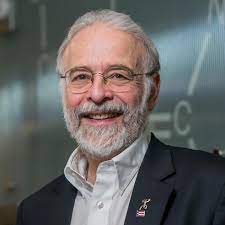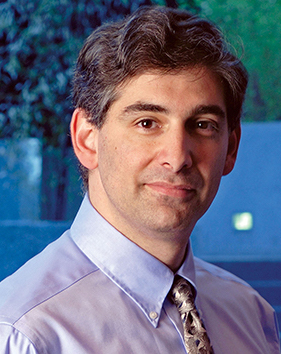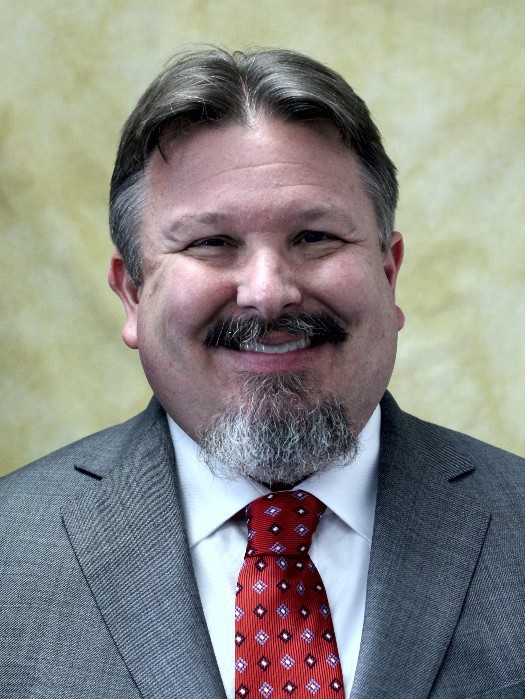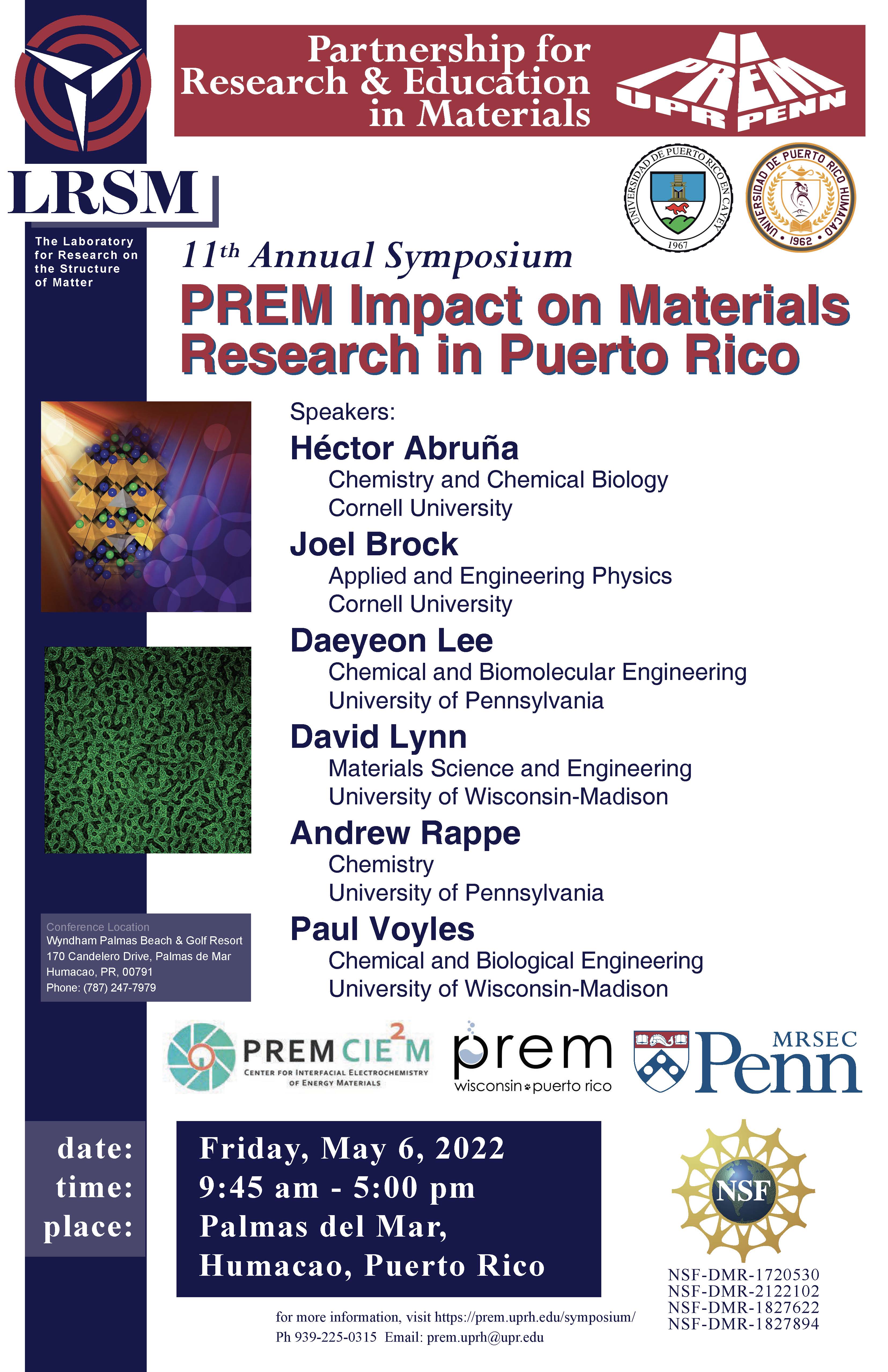The Symposium ...
The Symposium will be held on Friday May 6th, 2022 from 9:45 am until 5:00 pm at Palmas del Mar, Humacao, Puerto Rico. The program will include lectures by distinguished invited speakers followed by a research poster session.
The deadline to register online and to submit titles for poster presentations is Friday April 29th, 2022 or until all seats are occupied.
This event has been hosted by the University of Pennsylvania Materials Research and Engineering Center and the PENN-UPR Partnership for Research and Education in Materials (PENN-UPR PREM) since 2007. The 2022 PREM Symposium is organized in collaboration with the Center for Interfacial Electrochemistry of Energy materials (CIE2M) and the Wisconsin - Puerto Rico Partnerships for Research and Education in Materials.
New
Poster Preparation. Standard poster sizes used in materials-related conferences, i.e. MRS, APS, ACS, etc., will be accepted, although vertical posters of approximatelly 36 in (width) by 48 in (length) are preferred.
COVID-19 Safety. This event is hosted by the University of Puerto Rico and current covid regulations in that institution will be followed. All participants will be required to wear appropriate face masks while in the conference. Attendes are expected to frequently wash and sanitize their hands, to be fully vaccinated, and to cancel their participation if they experience any COVID-19 symptoms.
Featuring the following speakers:
 | Héctor Abruña is the Emile M. Chamot Professor in the Department of Chemistry and Chemical Biology at Cornell University. The Abruña group performs cutting-edge, interdisciplinary research to address problems of electrochemical interest, from fundamental studies of battery and fuel cell systems to molecular electronics. They employ standard electrochemical techniques in addition to X-ray methods, scanned probe microscopies (STM, SECM), NMR, nanoscale fabrication, electron microscopy (SEM, TEM), DEMS, and a variety of spectroscopic techniques (UV-vis, IR, Raman). His group also synthesizes novel, tailored inorganic complexes and organic battery materials to drive discovery of new chemical and electrochemical properties. |
 | Joel Brock is the Given Foundation Professor of Engineering in the School of Applied and Engineering Physics and Director of the Cornell High Energy Synchrotron Source (CHESS) at Cornell University. His group studies the fundamental processes governing deposition of complex oxide thin films via Pulsed Laser Deposition (PLD). Empirically, by tuning the substrate temperature, background gas pressure, laser pulse rate, and energy density of the laser pulse, high quality films of many cubic perovskite can be grown using PLD. Their time-resolved x-ray structural measurements directly test proposed growth models. He is also working to develop the next generation of x-ray sources. His long term goal is to generate, manipulate, and utilize coherent x-ray beams for atomic-scale structural measurements on the relevant fundamental time-scales. |
 | Daeyeon Lee is the Evan C. Thompson Term Chair for Excellence in Teaching Professor in the Department of Chemical and Biomolecular Engineering at the University of Pennsylvania. The vision of Lee's Soft Materials Research and Technology (SMART) Laboratory is to develop deep understanding of the interactions between soft materials (e.g., polymers, colloids and biologicals, etc.) near or at interfaces.They seek to extend the obtained knowledge to direct the assembly of macroscopic structures that have designed properties and functionality. Recent projects in the group include highthroughput synthesis and screening of soft matter/biological systems, infiltration of polymers into nanoparticle packings, interfacial complexation of polymers and nanoparticles, and development of bicontinuous biphasic systems for conversion and separations applications. |
 | David Lynn is the Duane H. and Dorothy M. Bluemke Professor and Vilas Distinguished Achievement Professor in the Department of Chemical and Biological Engineering at the University of Wisconsin-Madison. His research focuses broadly on (i) the design and synthesis of soft materials and (ii) the fabrication and physical characterization of macromolecular assemblies, nanostructured materials, and interfaces, with particular interests in the design of polymers and surfactants, reactive and non-wetting surfaces, and materials that address problems of biotechnological and biomedical importance. |
 | Andrew Rappe is the Blanchard Professor of Chemistry and Professor of Materials Science and Engineering at the University of Pennsylvania. His research group creates and uses new theoretical and computational approaches to study complex systems in materials science, condensed-matter physics, and physical chemistry. They look for new phenomena that occur when different components are brought together. For example, they examine molecules adsorbing on metal surfaces, in order to understand the effect of surface composition and structure on preferred adsorption sites, dissociation pathways, and vibrational dynamics. They also study how the compositions of oxide solid solutions lead to Angstrom-scale chemical structure, nanometer scale structural disorder, and long-range ferroelectric and piezoelectric properties. These studies find real-world applications in catalysis, corrosion, SONAR, fuel cells and other important technologies. |
 | Paul Voyles is a the Harvey D. Spangeler Professor in the Department of Materials Science and Engineering at the University of Wisconsin-Madison. His research focuses on the structure of materials. His two major research themes are (i) studies of the structure of amorphous materials using fluctuation electron microscopy, a technique his group has developed based on coherent electron nanodiffraction; and (ii) studies of defects and interfaces in crystalline materials and devices using extreme high-resolution imaging and microanalysis. Within these themes, his group works on a variety of materials systems, metals, semiconductors, superconductors, and complex oxides, and a variety of functional structures, including nanoelectronic, optoelectronic, and spintronic devices, catalysts, and functional interfaces. |
